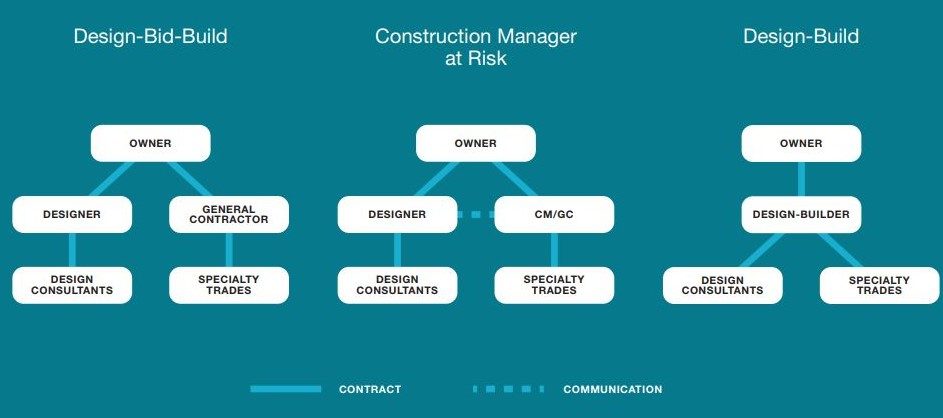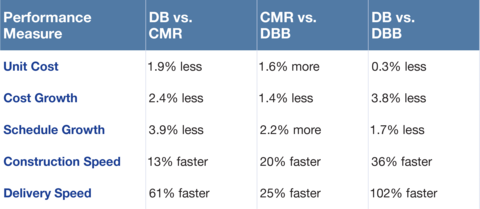Twenty years ago, the Construction Industry Institute (CII) published a report titled “A Comparison of U.S. Project Delivery Systems.” This report evaluated the performance of design-bid-build (DBB), construction manager at risk (CMR) and design-build (DB) projects. The analysis revealed that design-build projects outperformed both construction manager at risk and design-bid-build in terms of unit cost, cost and schedule growth, and all metrics relating to the speed of delivery.
In the decades since, design-build has become the most popular and fastest growing method of construction, delivering nearly half of America’s projects as of 2018. The CII recently reevaluated the most common construction delivery methods today, and design-build still comes out on top: After 20 years, design-build projects are still delivered faster and with greater reliability in cost and schedule performance.

Source: https://dbia.org/wp-content/uploads/2018/11/Cost_Performance_Research-CII_Pankow2018.pdf
Proliferation of design-build construction
Twenty-five years ago, design-build was considered radical. Today, it is the preferred approach to commercial construction. Owners are consistently choosing design-build over other construction methods. This approach delivers architectural design and construction services under one contract with a single point of responsibility, which streamlines the process and saves building owners time and money.

Source: https://dbia.org/wp-content/uploads/2018/11/Cost_Performance_Research-CII_Pankow2018.pdf
The difference in cost
The newest research yielded results consistent with the 1998 CII benchmark report, with design-build performing the best in both unit cost and cost growth. On average, projects using design-build are expected to cost 1.9% less per square foot when compared to construction manager at risk, and 0.3% less when compared to design-bid-build

Source: https://dbia.org/wp-content/uploads/2018/11/Cost_Performance_Research-CII_Pankow2018.pdf
Unit cost indicators
With design-build, cost per square foot is reduced by successfully maintaining the following conditions:
- High team chemistry among the owner, designer and builder
- Open book contracting terms, such as a cost plus a fee with a guaranteed maximum price
- Lower initial contracted unit cost
Cost growth indicators
The new study showed that design and construction costs can be best controlled by:
- Using a design-build delivery system
- High team chemistry between owner, designer and builder
- Small gross square footage of project
- Open book contracting term
- Early involvement of the builder
The difference in speed
Again consistent with previous results, design-build in the 2018 study was the best-performing project delivery system in terms of schedule growth, delivery speed and construction speed. On average, design-build projects are delivered 13% faster during construction and 61% faster from design through final completion when compared to construction manager at risk projects. Even more disparate, design-build projects are delivered 36% faster during construction than design-bid-build and 102% faster over the entire project duration.

Source: https://dbia.org/wp-content/uploads/2018/11/Cost_Performance_Research-CII_Pankow2018.pdf
Schedule performance indicators
The following conditions have the largest impact on schedule performance:
- Using a design-build delivery system
- Participation of the designer and builder in project goal-setting
- Early involvement of the builder
- Lower project complexity
- Private funding source
- Simpler foundation systems, such as slab-on-grade
- Larger gross square footage of the project
- Higher initial contracted unit cost
Design-build construction offers clear advantages
When it comes to the highest performing project delivery method, design-build can’t be beat. As seen in case studies of the most successful projects, bringing the architect, engineer and construction teams together early creates efficiencies time and time again. According to the CII report, having all team members engaged in the design process is critical to the early progress of a successful project. The designer and contractor work together from the beginning, providing unified direction to fit the owner’s schedule and budget. The collaborative nature of design-build is what continually sets it apart.
If you are considering design-build for an upcoming commercial or industrial construction project, contact Bobbitt today for more information about how design-build can work for you.

